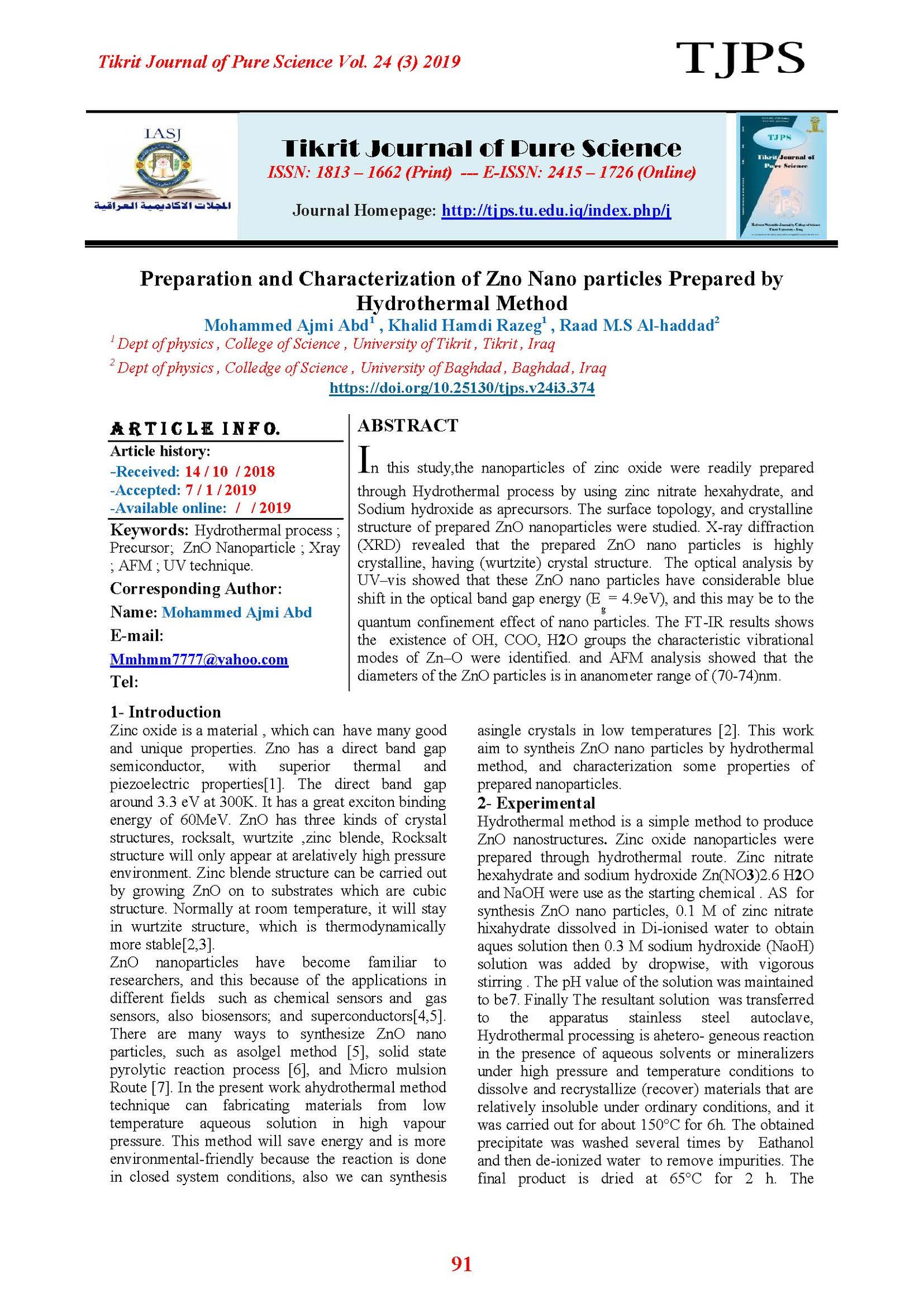Preparation and Characterization of Zno Nano particles Prepared by Hydrothermal Method
Main Article Content
Abstract
In this study,the nanoparticles of zinc oxide were readily prepared through Hydrothermal process by using zinc nitrate hexahydrate, and Sodium hydroxide as aprecursors. The surface topology, and crystalline structure of prepared ZnO nanoparticles were studied. X-ray diffraction (XRD) revealed that the prepared ZnO nano particles is highly crystalline, having (wurtzite) crystal structure. The optical analysis by UV–vis showed that these ZnO nano particles have considerable blue shift in the optical band gap energy (Eg = 4.9eV), and this may be to the quantum confinement effect of nano particles. The FT-IR results shows the existence of OH, COO, H2O groups the characteristic vibrational modes of Zn–O were identified. and AFM analysis showed that the diameters of the ZnO particles is in ananometer range of (70-74)nm
Article Details

This work is licensed under a Creative Commons Attribution 4.0 International License.
Tikrit Journal of Pure Science is licensed under the Creative Commons Attribution 4.0 International License, which allows users to copy, create extracts, abstracts, and new works from the article, alter and revise the article, and make commercial use of the article (including reuse and/or resale of the article by commercial entities), provided the user gives appropriate credit (with a link to the formal publication through the relevant DOI), provides a link to the license, indicates if changes were made, and the licensor is not represented as endorsing the use made of the work. The authors hold the copyright for their published work on the Tikrit J. Pure Sci. website, while Tikrit J. Pure Sci. is responsible for appreciate citation of their work, which is released under CC-BY-4.0, enabling the unrestricted use, distribution, and reproduction of an article in any medium, provided that the original work is properly cited.
References
[1] Almoqayyad, S .I. (2012). Study of Synthesis and Growth of ZnO Nanoparticles. M,Sc.thesis, Al-Azhar University of Gaza.
[2] Idris, W.A. (2015). Characterization of Nanostructure ZnO synthesized through hydrothermal method, M.Sc. thesis, University of Tun Hussein Onn Malaysia.
[3] Chowska, K .Z. (2014). Methods of ZnO nanoparticles synth-esis. Journal of Biotechnology, Computational Biology and Bio nanotechnology, 95(2):150-159.
[4] Amin, G. (2012). ZnO and CuO Nanostructures; low tempera-ture growth Characterization, Their Optoelectronic and Sensing Applications. M,Sc. thesis, Linköping University.
[5] Kolekar, T.V.et al. (2013). Synthesis and characterization of ZnO nanoparticles for efficient gas sensors. Archives of applied Science research, 5 (6):20-28.
[6] Teklemichael, S.T. (2012). Defects in zinc oxide nanocrystal. Ph. D. thesis, Washington state University.
[7]-Kumar, H. (2013). Structural and optical characterization of ZnO Nanoparticles synthesized by micro emulsion route. International letters of chemistry; physics and astronomy, 14: 26-36
[8] Reddy, A.R. (2015). Hydrothermal synthesis and characterization of ZnO nano Crystals. International journal of minning and metallurgy , 3(2): 52-56.
[9] Vinosel, V. M. et al. (2017). Facile synthesis of CuO nano particles by hydrothermal method and their application on their antibacterial activity. International research Journal of enginering and Technology, 4(8): 106-109
[10] Poole, C.p. (2003). Introduction to nanotechnology. John Wiley and sons, Inc.
[11] Kulkarni, S.S. (2015). Optical and Structural properties of zinc oxide Nanoparticles. international journal of advanced research in physical science , 2(1):14-18.
[12] Alwan, M.A. et al. (2015). Synthesis of zinc oxide Nanoparticles Sol Gel route and their charecterization. Nanoscience and technology, 5(1): 1-6
[13] Munoz, M.M. et al. (2017). Shape-control of zinc oxide Nanoparticles; enhancing photocatalytic activity under UV irradiation. International Congressof Engineering physics, IOP pulishing. series 792/ 012068.
[14] Kannaki, K. et al. (2012). Hydrothermal synthesis of CuO Nano structure and their Charecterizations. International journal of Scientific and engineering research, 3(9): 1- 4.
